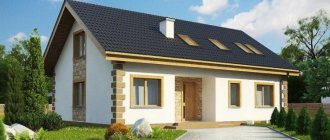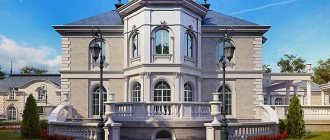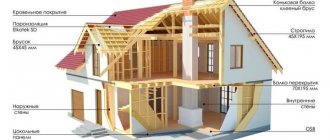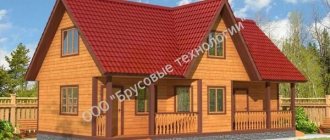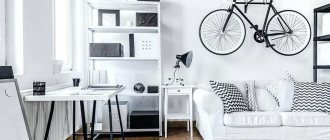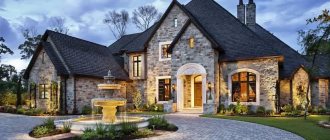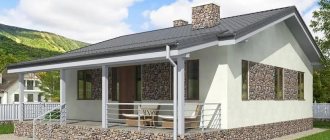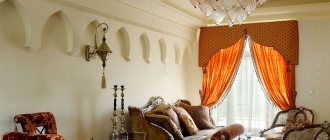04/19/2020 Category: Cooking stove
Description:
A two-story country house made of aerated concrete is inspired by oriental motifs: a low, almost flat roof, far protruding eaves, large windows and stained glass with a characteristic glazing. External exoticism is very successfully combined in the house design with a modern, comfortable and functional layout. The house has two full-height floors. The entrance is preceded by a covered terrace, the canopy of which is supported by three columns. A small vestibule leads to the hallway, the distribution area of the house. From here you can get to all its premises. Of particular interest in this layout is the guest space - this is a spacious room with a bay window, a fireplace and access to a glazed veranda. A dining table will fit perfectly into the bay window. The veranda can also be used as a winter garden. On the second floor there are four bedrooms and a bathroom. The corridors and halls here are reduced to a minimum, which is what made it possible to obtain such a large amount of living space. The result was a country house project that was non-trivial in architecture and rational in layout. Maximum number of residents: 6 people.
The house project is designed for construction in a climate zone with the following indicators
: — Estimated outside air temperature: minus 26°С — Snow: 180 kg/sq.m. — Wind: 30 kg/sq.m. — Soil freezing depth: 1.40 m from ground level.
Furnace:
Yes.
Fireplace:
yes.
Terrace:
yes.
Room on the 1st floor:
yes.
Balcony:
yes.
Veranda:
yes.
Built-up area:
168.40 sq.m.
Premises area:
198.40 sq.m.
Area of balconies and terraces:
29.50 sq.m.
Total area of the house:
207.30 sq.m.
Living area:
117.20 sq.m.
Construction volume:
1313.50 cubic meters.
Height of the 1st floor:
2,950 m.
Height of the 2nd floor:
3,000 m.
Height of the house at the ridge from ground level:
9,020 m.
Technology and design:
Construction of a house from aerated concrete blocks.
Foundations:
shallow monolithic reinforced concrete slab.
External walls: Internal walls:
375 mm thick.
from aerated concrete blocks. Partitions:
100 mm thick.
from aerated concrete blocks. attic floor - frame cladding. Floors:
planks on wooden beams.
Chimneys and ventilation
channels: made of solid red brick.
Facade finishing:
plaster + wooden strip.
Roof:
wooden.
Roof:
pitched on wooden rafters.
covering - bitumen shingles. Exterior finishing:
plinth - stone finishing. walls - plaster + painting.
Engineering solutions:
— Heating: autonomous from the boiler. — Ventilation: natural supply and exhaust. - Water supply: from a well (var. - from an external network). — Hot water supply: from an autonomous boiler. - Sewerage: to local treatment facilities (var. - to the external sewerage network) - Electricity supply - from the external network.
Overall dimensions of the house:
14.80 x 13.50 m.
Minimum lot dimensions:
21.00 x 20.00 m.
Mirror projection:
yes.
(without engineering systems) NOTE:
-
Contents of the design documentation:
- Architectural and Construction section (AR + KR) = yes. — Engineering sections (OV, VK, EO) (IS) = yes. (in direct projection)
Few of our clients decide to build a house for permanent residence in an exotic style. But our last work was just from the category of non-standard architectural projects. The customer needed a Chinese-style guest house project.
By the time the client contacted him, the foundations of all planned structures had already been erected on his site - a house, a garage and a guest house. The first two were designed by another agency, but the client decided to order the guest house from us.
According to the plan, the entire ensemble of buildings should use elements of Chinese architecture.
Chinese style. What is he like?
Having decided to build a house in the Chinese style, you need to be faithful to it to the end. After all, the main feature of the style is the philosophical meaning of the surrounding material things. Each detail is ordered and harmonious, transmitting one or another energy force according to the teachings of Feng Shui.
The beginning of a unified system is taken already in the natural landscape on which the future building will be located. A Chinese-style structure should blend in with the surrounding landscape and look as natural as, for example, trees or flowers in a garden.
Therefore, Chinese architecture is characterized by smooth lines, the use of natural materials, and natural colors.
Natural wood was often used to decorate the exterior of the house, which was coated with bright red or black varnish.
The recognizable shape of the Chinese roof has a high roof with steep slopes, which is due to the natural feature of the Celestial Empire - frequent heavy rains, as well as the philosophical side, where mythology associated with dragons occupies a very important place.
A Chinese-style house should be permeated with sunlight. For this purpose, it is not even customary to curtain windows, and window openings are made of large sizes.
The use of gold-plated and mother-of-pearl details in the design is typical. A typical decorative element is images of dragons. The image of a Chinese house will not be complete without the typical street lanterns, decorated with tassels and painted with hieroglyphs.
Preparatory work
Before you begin drawing up a future site plan, you need to decide on the terrain itself, the nature of the relief, the shape of the land, the presence of any buildings, as well as other features of the area. For example, in rural areas there are a large number of streams and reservoirs, if one is present on your site, then you can use it correctly.
Plot with a stream
Please note several features of the location of the dacha:
- lowland - hill;
- presence or absence of a water source;
- wooded area - steppe.
Quite often it is necessary to add or remove soil, make blind areas for walls, and also make organized drains. Only with proper placement of buildings on the site can you make maximum use of the dacha plot and highlight all the zones.
Sometimes leveling of the area is required
To ensure that all the preparatory work is done correctly, it is best to assess the space and start from the ground.
- Relief: hilly, flat, with ravines or mountains. The layout of utility lines will depend on this indicator.
- Soil: clayey, humus, sandy. If you plan to equip a vegetable garden, you should increase the soil fertility by applying fertilizers. The set of plants for the garden and flower beds will depend on the acidity level.
- Shape and size of the territory: square, rectangular and elongated.
- Groundwater: If the level is high enough, consideration should be given to drainage and removal of water.
- Climatic conditions.
- Illumination.
Chinese style house project in a modern application
Look at the photo of our guest house with elements of the surrounding landscape. The area near the building is decorated with winding stone paths; the same smoothness of lines can be seen in the structure of the house itself and its component parts - from the curved roof, ending with ornate images of dragons on the corners of the roof, decorative balls of the terrace fencing, concave table legs in the barbecue gazebo. The presence of stones in the exterior can be mistaken for a stone garden.
The roof is designed only as an imitation of the Chinese one (without the use of special construction technology, far protruding corners and multi-tiered structures).
The design of our Chinese-style house uses facing bricks, natural stone, wooden consoles, flexible tiles, decking boards and natural noble wood.
The entire exterior of the building is planned on a “natural” harmonious contrast of light and dark (almost black) shades of natural wood, which fit so naturally into the natural landscape.
A characteristic feature of the Chinese style are large window openings, ready to warm the inhabitants of the house with life-giving sunlight. The glass is decorated with an abundance of crossed perpendicular lines of the frame binding, forming rectangles of different sizes. Such elements are also typical of Chinese homes.
The shine of mother-of-pearl is present in the design of decorative balls on the terrace fencing. The red color in the exterior is only indicated in the decor by hieroglyphs and tassels of street lamps.
Site layout. Placement of buildings
1- The house design you like must be “linked” to the “geography” of the site. Usually the entrance doors of the house are not oriented towards the street. It is better if its short side faces there, and its long side “looks” deep into the site.
Note: To decorate the entrance to the house, we can recommend a platform made of rubble and concrete with flowers along the edges, a carved wooden porch with an original lamp, a pergola entwined with greenery, several boulders with pebbles and gravel and, in combination with decorative shrubs, a terrace entwined with a vineyard.
Internal structure of the guest house
The interior layout of the guest house project is no different from any country cottage. There is a vestibule, a living room-kitchen-dining room, a bedroom, a dressing room, a bathroom, as well as a covered terrace with a barbecue gazebo and a woodshed for pleasant outdoor meals.
The total construction area is 152.5 sq. m. m.
An integral element of any country house - a fireplace - will be located in a cozy living room-kitchen-dining room. Combining three rooms will make the room brighter, more spacious and convenient for serving guests.
Plan diagram
Once the important points have been identified and various layout options have been explored, you need to sketch everything out on a piece of paper. You can seek help from specialists, landscape designers who use special programs to develop the project. But to save money, a regular sheet of A4 paper and a pen (pencil) will be enough.
Sketching ideas
To sketch the plan, consider an example - a 10-acre dacha plot. It is best if you take a scale of 1:100 and a sheet of whatman paper of the appropriate size - a square of 50x50 cm. For convenience, it is better to arm yourself with a pencil and a ruler to line the entire sheet into a grid in increments of 1 cm. Next - a flight of fancy: arm yourself with colored pencils, clippings from magazines and felt-tip pens, with the help of which you can create a real collage.
When working with the diagram, you must take into account:
- location of the house taking into account all exits;
- places allocated for outbuildings and auxiliary buildings;
- rest zone;
- playground;
- paths;
- fence;
- flower beds, rock gardens and front gardens;
- bodies of water;
- engineering Communication.
When preliminary placing objects, you should select the optimal location that will suit the purpose.
Option No. 2 with minor changes
The oriental style in the minds of most individuals includes exoticism, bright colors, songs and dances. These include the culture of China, Morocco, Turkey, Japan, India, and the United Arab Emirates. These countries have always attracted tourists with their love for their traditions, despite fashion trends. The oriental style in the interior has always stood out for its color and comfort, so modern housing decorated in this style will always be appropriate.
Oriental style is a rather vague concept. It is mainly divided into:
- Arab;
- Asiatic.
The room with an Arabic-style interior contains the following elements.
- Lots of small details.
- All colors are rich and catchy.
- All lines are streamlined, there are no corners.
- The ceilings are vaulted.
- There is a large amount of ornamentation and carvings.
- A large number of different textiles are used in the design.
In such a room you want to relax, unwind, and escape from extraneous thoughts.
The room, decorated in Asian style, is distinguished by its minimalism. It is characterized by:
- large windows letting in a lot of light;
- a minimum amount of decor and furniture.
Separately, we can say about Japanese and Chinese styles. They are distinguished by their restraint and conciseness. More minimalist - Japanese. The room, decorated in Japanese style, is dominated by natural colors: white, gray, brown, beige.
The interior of the Chinese style is distinguished by the use of a large number of bright colors such as red, yellow, green, and blue.
People with different life principles, financial status, and political views can be lovers of oriental interiors.
Color spectrum
The homes of Japanese residents are characterized by natural shades (sakura, beige bamboo, dark walnut, water lily). Black, cherry, and brown are used as contrasting tones. The walls usually have a light matte finish. It is customary to make the ceiling here pastel.
Decorative elements in a Japanese home should also be of natural origin. These can be branches of bamboo or cherry blossoms. Fans are hung on the walls. Tokonome niches are made in the walls, where various miniature vases, figurines or other objects are placed.
Bedroom decoration in traditional Japanese style Source artshum.com.ua
Distinctive features of the room design
For people who are not familiar with the subtleties of design, the concept of oriental style includes all its subtypes. But, it is still possible to identify features that are unique to this direction.
Zoning.
The design of a house or apartment should begin with the distribution of functional zones. If the room is spacious, then it can be divided. For example, the living room. Traditionally, it can be divided into a place for relaxation and a dining room. Everything is combined in a small room.
The “king” of the relaxation area is a huge sofa. For convenience and comfort, a large number of pillows are provided. The upholstery is always smooth, pleasant to the touch, and in rich colors. A wide, low table is installed in front of the sofa. You can put a hookah and treats on it. The same piece of furniture can be placed in the dining room.
Oriental style in interior design
Modern room design in oriental style
Oriental style room interior
Decoration of walls, ceiling, floor.
When decorating rooms in an oriental style, you need to stick to 2 options: use bright shades or pastels. Natural finishing materials are preferable: bamboo, wood, some types of metal. Relief is not necessary for the walls; they can be in warm shades: sand, cream, beige.
You can “put” stone or wood on the floor. The ceiling is usually white, but you can play with contrast and make the floor and walls the same color.
You can place several large dark beams on the ceiling.
The oriental interior is distinguished by smooth, soft forms with painting applied to them. The ceiling can be suspended, have several levels; the use of decorative overlays with a variety of imitation is popular.
The walls can be painted or covered with wallpaper. Preference is given to materials made of gold, silver, and with eye-catching ornaments. The wallpaper can be plain, but the shade must be warm: gold, orange, brick.
The wall can be decorated with colorful carpets, ostrich feathers, ancient weapons, and knives.
Oriental style in the interior of the apartment
Apartment design in oriental style
Furniture.
In oriental interiors, they prefer furniture made from natural materials.
Massive soft sofas are installed when decorating a room in Arabic, Moroccan, Indian styles. In all other areas, preference is given to small ottomans and armchairs. For upholstery, materials such as silk and velvet are used.
The Indian interior also stands out with its smooth lines. Chinese and Japanese, on the contrary, highlight straight lines, squares, rectangles; you can install wicker furniture.
Decor and additional accessories.
All types of oriental style in the interior pay great attention to detail. However, every little thing has a specific meaning. Portraits and sculptures of people are excluded. The most preferred are ornaments. They can be anything and can be applied to almost anything: furniture, dishes, textiles, clothes, carpets, tablecloths.
A large carpet with ornaments is highly valued in the East. They can hang on the wall or cover the entire floor.
Accessories can be lamps of different sizes, on which embossing, beads, silk threads, traditional hookahs, jugs, porcelain cups, dishes for sweets, chandeliers, vases of different sizes are applied. Accessories made from bamboo are very popular.
Ideally, a small fountain, an aquarium, a waterfall, or an artificial pond would fit into a room decorated in an oriental interior.
As bright accents, you can place paper lanterns and massive fans around the perimeter of the room.
The atmosphere of a fairy tale is created by a large number of colorful textiles: cushion covers, sofa and chair covers, curtains.
Oriental style in interior design
Modern room design in oriental style
Oriental style room interior
Why not dream of a “sheikh’s home”?
Do you want something unusual, interesting and well-made by professionals? Let tradition be complemented by fresh ideas.
InnovaStroy specialists will compare the interior with the exterior and develop a cost-effective project for an elite house with a swimming pool and a garage. The facade will look light, “airy”, symmetrical, and the building itself will be spacious and voluminous. Your estate can be decorated with a beautiful gazebo in the style typical of nobles of Arab countries - a white fabric tent with Moroccan poufs and wicker chairs.
A luxurious living room will occupy the first floor, bathrooms and bedrooms will occupy the second floor. Just imagine living room walls shining with precious stones, luxurious bedrooms with huge beds decorated with fine carvings. Your bathroom will rival those found in spas, and your kitchen can easily rival those in upscale restaurants.
By designing wide sliding panels to the terrace, you can provide convenient access to the courtyard to a luxurious swimming pool, a courtyard decorated with vegetation and small statues. Artificial small ponds, the bottom of which is lined with pebbles, and fountains that decorate the yard and soothe with their murmur are also used as decorations for the territory. This approach is ideal for those who value comfort, luxury and peace of mind.
Bedroom decoration
A bedroom decorated in oriental style represents lightness. It is distinguished by the following factors.
- Lightweight, weightless fabrics.
- Natural materials.
- Geometric lines.
- Low placement of furniture.
- Bright, rich shades.
The main decoration is a massive canopy bed. Thick curtains with tassels and fringes are hung on large windows. There must be a lot of accessories and additions: small colorful pillows, carpets and runners, lamps, floor lamps.
Oriental style in the interior of the apartment
Apartment design in oriental style
Living room decoration
Classic Europeans will be unfamiliar with the oriental style of the living room. The color palette used is very colorful and rich, preference is given to such shades as red, orange, ocher, peach, emerald, aquamarine, honey.
The walls of the room will look expensive and chic if you use silk-screen printing for decoration. You can also simply paint them in a warm, natural shade. In a Chinese interior, you can play with contrast and make one of the four walls brighter.
If the room is large, with high ceilings, then you can make them dome-shaped. Details are decorated with ornaments, paintings, and a variety of lighting fixtures.
Oriental style in interior design
Modern room design in oriental style
Oriental style room interior
The floor is decorated with parquet boards or ceramic tiles. The colors and patterns of the finishing material are selected to create a meaningful pattern. When decorating a Japanese or Chinese style, cork will look harmonious.
The living room must have upholstered furniture. The owner himself determines what it will be - luxurious or discreet. The upholstery can be decorated with silk thread.
Additional items may be:
- stools;
- low tables;
- cabinets;
- wall and floor shelves;
- fireplace.
It is for tea drinking that you can install a wide table and next to it, lay out several small pillows on the floor.
Oriental style in the interior of the apartment
Apartment design in oriental style
Site layout. Design selection
Important: The main thing is to immediately determine where and what will be located.
It is difficult for every owner, and there is no need to give ready-made recipes for planning a site, especially for its decorative design. Here everyone is free to do as they please. After all, even by placing the paths - not straight, but diagonally or even, if conditions allow, with several curves - you can create comfort.
A fairly common mistake for beginners is combining trees, berry beds, flower gardens and even garden beds on the same site. Within a few years it will become clear that they began to interfere and harm each other.
There are many options for rational planning and it is unlikely that you should give preference to any particular one. It is only important to focus on the following requirements imposed by common sense, plant biology, sanitary standards and the rules of good human relations.
Kitchen decoration
When developing a kitchen design, you can safely imagine and combine several oriental styles.
- Basic preferences.
- Shades should only be warm.
- You can highlight several accents with bright colors.
- Working materials are only natural.
- All furniture is on low legs.
- A large amount of textiles.
- A large number of different dishes for tea drinking.
- All shapes are smooth and rounded.
The interior of a kitchen in an oriental style is easy to create yourself. It is enough to use a small mosaic when decorating a kitchen apron; it is better if the wallpaper is silk, but it can also be made of paper or panels, preferably cork. Decorative vaults, beams or gratings are suitable for the ceiling; the color scheme can be any.
Windows play a big role in decorating a room. As an option, replace regular glass with frosted glass, apply several hieroglyphs or an oriental ornament to it. You can protect yourself from the sun using bamboo curtains.
Oriental style in interior design
Modern room design in oriental style
Oriental style room interior
Shapes of plots
Rectangular plot
Options for planning a summer cottage can be very diverse, but almost everything will depend on the shape of the land plot. The most common type of plot is a rectangular shape, on which it is possible to implement a wide variety of solutions and ideas. There is also an L-shaped type of plot. It is quite complex, so you will need to think and think about where and how to place everything. The part that protrudes can be used as a place to relax or as a playground.
Triangular plot
On a triangular-shaped site, you can consider an asymmetrical approach when planning and dividing the territory. The emphasis should be on round elements:
Round flowerbed on a triangular plot
It is best to place outbuildings in remote corners.
Planning is a creative endeavor. Experts advise considering a wide variety of options, but not copying them completely, but making some changes.
Decoration of the hallway and loggia
When you first enter a house whose corridor is decorated in an oriental style, you may be very surprised and confused. A large number of lighting fixtures, vaults, and arches catches the eye. A great place to play with contrast. Walls painted in light colors can be diluted with dark beams or panels, images of sakura, and ornaments. The lighting should not be too bright. Ideal if it is muted. If the hallway area is small, one lighting fixture will be enough. If more than 3-4 meters, a larger quantity will be needed.
Oriental style in the interior of the apartment
Apartment design in oriental style
Recently it has become very fashionable and practical to design a loggia as a separate room. The designer is offered a huge number of ideas on how to design it. This could be a place to relax, an office, a bedroom. All surfaces can be covered with wood, textiles, bamboo. It all depends on the financial capabilities of the owner. Light colors can be diluted with brown, gold, and purple.
Having decided to create an oriental-style interior in your home, you must remember that it will always create a feeling of a fairy tale, a mystery, a holiday; you will always have bright colors and meaningful ornaments before your eyes. The room will be calming and relaxing. For a complete feeling of relaxation, you can install candles or sticks with the scents of patchouli, jasmine, orange, and cinnamon in the room.
Site layout. Where to place the vegetable garden?
It is better to arrange gardens and vegetable gardens of two adjacent plots “face to face”, to each other. Then there will be no offense that your tree shades the neighbor’s garden bed or vice versa.
Give your garden the sunniest, warmest location with enough space to move vegetables from one bed to another every year and thereby maintain proper crop rotation.
Note: In such a rotation of vegetable crops, also include garden strawberries, which will give you more opportunities to maneuver the land area of your garden.
The “geography” of the location of the garden should also take into account other factors: good protection from the northern and prevailing winds for the area, increased relief is desirable, although lower areas of land can also be given to cabbage and root vegetables.
